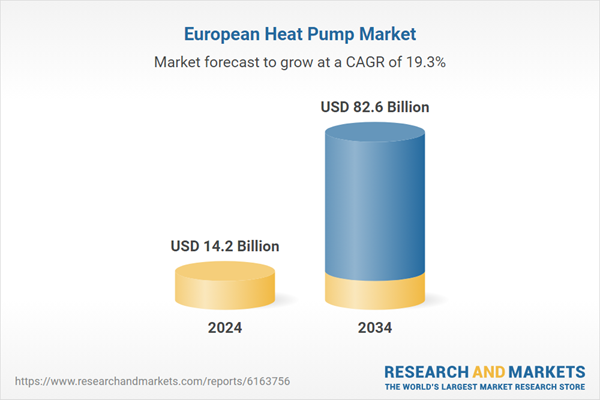Tighter measures to reduce greenhouse gas emissions are driving demand for energy-efficient solutions, fueling the growth of low-carbon technologies. The European Union has set ambitious environmental targets, prompting member states to adopt strategies that minimize carbon footprints. The demand for sustainable systems continues to grow, further supported by ongoing research, government-backed projects, and initiatives aimed at reducing environmental damage. Consumer awareness around environmental sustainability is shifting market dynamics, ensuring a steady increase in heat pump adoption across the region.
The air source heat pump segment is expected to dominate, accounting for a 93% share in 2024. Air source heat pumps (ASHPs) are anticipated to reach USD 80 billion by 2034, with a projected growth rate of 19%. These systems are gaining traction due to their versatility, ease of installation, and cost-effectiveness, especially for residential buildings. Their ability to provide both heating and cooling makes them a highly sought-after solution. The availability of financial incentives, including tax credits and clean energy initiatives, will further boost the growth of air source heat pumps across Europe.
The residential segment held a 71.3% share in 2024 and is expected to grow at a CAGR of 19% from 2025 to 2034. As energy-efficient heating and cooling become more essential for homes, apartments, and commercial buildings, the demand for residential heat pumps is set to rise. With increasing pressure on consumers to adopt cleaner energy solutions, the uptake of heat pumps for residential applications is expected to accelerate rapidly.
Germany Heat Pump Market held a 14% share in 2024, generating USD 1.9 billion. Rising consumer awareness about environmental issues and a strong push for sustainability are driving the demand for eco-friendly heating solutions. As the market continues to embrace energy-efficient alternatives, heat pumps are becoming a cornerstone of modern heating systems in homes and businesses across Europe.
Key companies in the Europe Heat Pump Market include Carrier, Fujitsu, Panasonic, Daikin, Glen Dimplex, Aira, Gree, Bosch, LG, Trane, Kensa, Mitsubishi, Nibe, Stiebel, Toshiba, Swegon, Wolf, Viessmann, Systemair, and Vaillant. Companies in the European heat pump market are adopting a variety of strategies to solidify their market position. Key approaches include investing heavily in R&D to develop more energy-efficient, cost-effective heat pump solutions that meet increasingly stringent environmental standards. Partnerships and collaborations with governments and other organizations are central to gaining access to financial incentives and public sector projects. Additionally, many companies are focusing on expanding their product offerings to include advanced, customizable solutions that cater to both residential and commercial needs.
This product will be delivered within 2-4 business days.
Table of Contents
Companies Mentioned
The companies profiled in this Europe Heat Pump market report include:- Aira
- Bosch Thermotechnology
- Carrier
- Daikin
- Finn Geotherm UK
- Fujitsu General
- Glen Dimplex Group
- Gree Electric Appliances
- Kensa Heat Pumps
- LG Electronics
- Mitsubishi Electric
- Nibe Industrier
- Panasonic Marketing Europe
- Samsung
- Stiebel Eltron
- Swegon Group
- Systemair
- Toshiba EMEA
- Trane Technologies
- Vaillant Group
- Viessmann
- Wolf
Table Information
| Report Attribute | Details |
|---|---|
| No. of Pages | 150 |
| Published | July 2025 |
| Forecast Period | 2024 - 2034 |
| Estimated Market Value ( USD | $ 14.2 Billion |
| Forecasted Market Value ( USD | $ 82.6 Billion |
| Compound Annual Growth Rate | 19.3% |
| Regions Covered | Europe |
| No. of Companies Mentioned | 23 |









